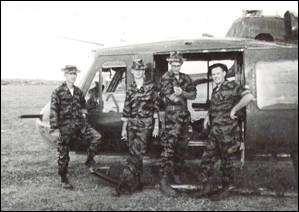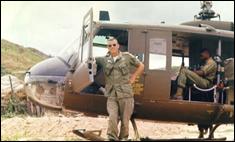CAPTAIN JOHN W. “JACK” GREEN III
Army Aviator
Founding Member and Past President of the 281st AHC Association
DAT:
11-12-2010

Captain Jack Green and crew of 1st Delta mission
(Jack is last person on right)
 Captain
John W. "Jack" Green left us on his final mission on December 11, 2010 in his
home town of Baton Rouge, LA. Jack was an officer and a gentleman who earned the
respect of the Intruder family. As
a young army aviator jack joined the 145th Aviation Platoon In 1965 when it was
assigned the mission of providing direct support to the 5th Special
Forces Group in Vietnam, Jack served as a senior aircraft commander and
operations officer from 1965-1966.
Upon returning to civilian life in Baton Rouge Jack became a successful business
man, raised his family, was a founding member of the Intruder Association and
served as its president. Jack was involved in model railroading and organized a
national chapter of the model railroading association.
In the 145th Airlift Platoon which became a part of the 281st
AHC, Jack served as the operations officer and was the first Aircraft Commander
to fly a long range recon mission for Project Delta, the 5th
Special Forces Group reconaissance unit. Jack is also credited with being the first army
aviator the use the McGuire Rig to rescue a member of a recon team.
Captain
John W. "Jack" Green left us on his final mission on December 11, 2010 in his
home town of Baton Rouge, LA. Jack was an officer and a gentleman who earned the
respect of the Intruder family. As
a young army aviator jack joined the 145th Aviation Platoon In 1965 when it was
assigned the mission of providing direct support to the 5th Special
Forces Group in Vietnam, Jack served as a senior aircraft commander and
operations officer from 1965-1966.
Upon returning to civilian life in Baton Rouge Jack became a successful business
man, raised his family, was a founding member of the Intruder Association and
served as its president. Jack was involved in model railroading and organized a
national chapter of the model railroading association.
In the 145th Airlift Platoon which became a part of the 281st
AHC, Jack served as the operations officer and was the first Aircraft Commander
to fly a long range recon mission for Project Delta, the 5th
Special Forces Group reconaissance unit. Jack is also credited with being the first army
aviator the use the McGuire Rig to rescue a member of a recon team.

McGuire Rig (From
Wikipedia)
The “McGuire Rig” was used to extract soldiers from the
jungles of Vietnam. It would be suspended from a helicopter and used to extract
soldiers from areas without a suitable pick-up zone. It was simple, inexpensive,
and effective. Although less comfortable than the STABO (Short Tactical Air
Borne Operations)[1] harness, it did not require the soldier to carry any
special equipment. It was designed by Sergeant Major Charles T. McGuire, a
member of Project DELTA, a Special Forces reconnaissance project.
The McGuire Rig was fashioned from a 2-inch (51 mm) wide,
15-foot (4.6 m) long A7A nylon cargo tie-down strap with a quick-fit buckle on
one end. This was typically cut down to an 8-foot (2.4 m) length and a 18-inch
(460 mm) web loop (wrist strap) attached near the top end. This was used to form
a sling loop and attached to an over 100-foot (30 m) length of 5/8-inch nylon
rope. Three ropes with McGuire Rigs attached could be dropped from a UH-1 "Huey"
helicopter, all on the same side. A deployment back containing a sandbag carried
each rope to the ground. A soldier attached his rucksack with a snap link,
stepped into the loop, adjusted it, inserted his left hand in the wrist loop,
and on signal the helicopter lifted off. The three men would lock arms to
prevent oscillation and prevent falls if a rope was shot through. A wounded or
unconscious man could fall from the harness unless secured. The system did not
allow the extracted soldiers to be hoisted into the helicopter. They were flown
out of the danger area and then set down in a clearing in order to board the
helicopter. On a long flight the harness proved to be extremely uncomfortable.
From the pilot's standpoint, performing an extraction using
a McGuire Rig required intense concentration. Once the soldiers were in the rig,
the pilot would attempt to hover straight up. But with the nearest ground
reference over 100 feet away, it was difficult to discern when the chopper was
moving. There was the distinct possibility, therefore, that the soldier(s) would
be dragged through tree limbs during the extraction.
CPT John W. "Jack" Green, III, flying a UH-1B for the 145th
Airlift Platoon in support of Project Delta was the first pilot to utilize the
McGuire Rig in an emergency extraction. In mid-1966, 145th was blended into the
281st AHC which then assumed the mission of supporting Project Delta. Due to
intense training with the MACV Recondo School and on the job training with
Project Delta, the 281st AHC developed the usage of the McGuire Rig into an art
form.
Remembrances:
IN MEMORIAM
An officer and a gentleman went home today--mission accomplished. Jack Green died at 1:50 pm. He was peaceful and without pain. It was a privilege to hold his hand as he took his last soft breath. I could see the beauty of God's world in this good, kind, intelligent, brave man and I could feel God's love as He brought Jack home.
May God Continue to Bless Us All
Linda

JOHN
W. “JACK” GREEN III
Jack is survived by his wife, Linda Anderson Ydarraga
Green; two daughters, Erin Green Eason and Jena Green; stepdaughter, Cathy
Moffett; stepsons, Mark and Kevin Ydarraga; and thirteen grandchildren.
From Ken Smith
Dear Linda,
I want to tell for myself as well as the members of the
281st AHC Association and all those who served in the 281st (and its early units
like the 145th) that the loss of your beloved husband weights heavily on all us
who knew or knew of Jack. A true hero has left us, but he will never be
forgotten.
I, for one, did not know Jack or you as well as I wanted
too. I just know that Jack would always be there to support the 281st AHCA and
me personally. I recall clearly how he supported my efforts on the Airborne and
Special Operations Museum Monument and Dedication. It was, like, Jack was always
out there watching and supporting our efforts at all times. I will really miss
him a lot!
I want to be sure that you know that you are always a
member of the 281st AHCA, and I want to encourage you to stay in touch with us
and to be welcome at all 281st Reunions and other events. Please honor us by
staying close by and helping us remember Jack as a great man, a hero and a
warrior.
My deepest sympathy and regrets for your loss. Our hearts
and prayers go out to you and your family. The 281st sends Taps to a great man
and imagine a 21 gun salute as a back drop.
Sincerely and with deepest sympathy,
Ken Smith
President
281st AHCA
From Bob Mitchell
Bob Mitchell, on behalf of the 281st AHC
Association, Dec 19, 2010:
Yesterday, Al Smith, Jim Jackson, John Hyatt, Brian Paine
and I attended a Memorial Service for Jack Green in Baton Rouge. There were well
over 250 people in attendance, which is a testament to the fact that Jack Green
touched many lives during his time.
Of the speakers during the service, his Grand Daughter's was the most touching
and to the point. She spoke of her love for her Grandfather and paid tribute to
his military service. She said she had always known the he was in Vietnam, but
only recently learned of his heroic actions and the fact that he had been
decorated with the Distinguished Flying Cross on two occasions.
After the ceremony the five of us presented Linda Green with a Flag Case which
was furnished by the 281st AHC Association. She was very appreciative of the
Flag Case and grateful for our being there for Jack.
We were proud to represent all of you.